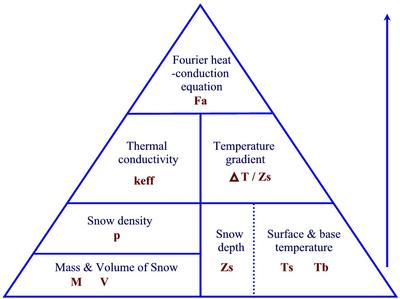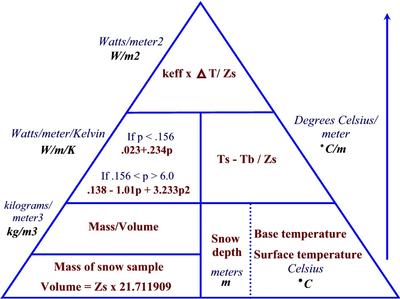5 April, 2002
Weather: Partly Cloudy
High 30
Low 4
Predictions
Using surface temperature, snow depth, and ice thickness data, what
do you think will happen to the snow and ice on Jalpertia pond within
the next two weeks?
Tsurf ------ Snow depth ------- Ice Thickness
March 2
-4.4 ëC -------- 30.4 cm ---------- 76.6 cm
March 9
-7.5 ëC -------- 29.4 cm ---------- 78.5 cm
March 16
-0.07 ëC ------- 27.1 cm ---------- 77.3 cm
March 23
-3.2 ëC -------- 26.1 cm ---------- 82.0 cm
March 30
-13.3 ëC ------- 27.5 cm ---------- 79.3 cm
The Science Behind Conductive Heat Flux (Heat Flow)
Well, you're about to become snow and ice experts and we're now on
the last phase of heat flow calculations.
To this point, we've talked about thermal
conductivity using snow density values from snow samples
and temperature gradient using base
and surface temperatures and snow depth. Remember, there are two
functions of heat flow: thermal conductivity and temperature
gradient. Once we've calculated those two functions, all we need to
do is multiply the two final values to determine heat flow. Not bad,
huh? See the Heat Flow Chart below for conductive heat flux
calculation procedures.
So, What Do You Think?
What are some factors that will influence heat flux?
Hint: How would the depth of snow
affect heat flux? See tomorrow for some examples and explanation.

1. Heat Flow Chart - symbols
On the bottom left of the pyramid, notice the mass and volume needed for snow density, which is used to calculate thermal conductivity. On the right side of the pyramid are three measurements (snow depth and two snow temperatures) used to calculate temperature gradient. Finally, multiply thermal conductivity and temperature gradient to find heat flow. See below for formulas.

2. Heat Flow Chart - units and formulas
Contact the TEA in the field at
.
If you cannot connect through your browser, copy the
TEA's e-mail address in the "To:" line of
your favorite e-mail package.
|
